A Global Perspective on New Military Technologies in National Security Strategies
How do states view technology in the context of security policy? A comparative analysis of the national security strategies (NSS) of twelve countries between 2017 and 2023 shows that there are different approaches to how security and technology are conceived. There is both consensus and divergence with respect to relevant technologies, and there are groups of “like-minded” states. NSS tend to take a comprehensive view of security, which is why dual-use technologies, especially in the cyber domain, AI or network technologies, are in focus – either as military resources or as threats. This poses considerable challenges for arms control.
The discussion about the influence of new military technologies and their relevance for (future) warfare and global stability has gained considerable traction over the last decade, especially in the context of the ongoing wars against Ukraine and in the Gaza Strip. Systems such as artificial intelligence (AI), in particular, have been instrumental in the development of decision support systems and uncrewed vehicles in all domains are being tested and in many cases integrated into military operations in current theaters of war. This discussion focuses on the potentially significant impact of technologies on national and international security and is driven by the central importance of not missing or losing sight of future breakthrough systems. This urgent need stems from the Janus-faced nature of certain modern technologies, which can be perceived as both an opportunity and a threat—both of which are time critical. On the one hand, new technologies offer the chance to take a leading role in global competition through rapid innovation, thereby gaining more autonomy, technological independence, and military power—not to mention civilian business opportunities. On the other hand, new technologies are often associated with security policy fears and threat perceptions, the relevance and significance of which are difficult to assess ex ante.
The Polish National Security Strategy, for example, argues:
“Development of solutions based on fixed line and mobile broadband (5G and subsequent generations), the Internet of Things, cloud computing, quantum technologies, automation of services, machine learning, nanotechnology, and artificial intelligence create new development opportunities for Poland, while generating previously unknown threats.”1
An important factor in this context is that many of the technologies currently considered to be of particular importance when it comes to national security are dual use, meaning they can be used for both military and civilian purposes. Further, as the above quote shows, many technologies were, by their very nature, initially civilian technologies, developed or advanced in the civilian sector. This is very different to the Cold War period, when the defense industry was much more innovative and military technology spilled over into the civilian sector more frequently.
However, different countries have different understandings of which technologies might be relevant in addressing their security problems in both the near and distant future. In the following, we will examine the results of a first qualitative content analysis of 19 National Security Strategies from 12 countries, published between 2016 and 2023, elaborating on the areas of consensus and the differences between the various states—both in terms of their understanding of security, and the technologies they see as important. This will not only help countries find “like-minded” states to cooperate with but will also highlight new military technologies and technological developments that are not yet on the radar or are in the blind spot of some of the states under scrutiny. Finally, the analysis offers insights into which fields technological dynamics are located. While some developments are genuinely military, others involve technologies that are dual-use . While regulation and restriction via arms control agreements can be achieved in principle, the regulation of dual-use products poses different and usually more complex problems.
The Importance of New Military Technologies
There is an ongoing debate as to whether new military technologies are playing a significant role on the battlefields of today and whether this is likely to continue into the future, thereby enhancing or endangering national security. While technology enthusiasts usually point to current developments in the Ukraine and Gaza conflicts, arguing, for example, that certain kinds of drones have become a major game changer in current warfare, critics argue that technology alone has never been a decisive factor and that other factors, such as strategy, tactics, military institutions, training, or culture—to name but a few—impact the relevance of technology. Moreover, some states have a very broad definition of national security, including technologies of limited military relevance, at least on the battlefield, while others adopt a narrower concept, both in their understanding of national security and when it comes to the relevant technologies.
In current debates, the term “emerging and disruptive technologies” (EDTs) has gained some traction in the context of national security, especially among military and political decision-makers. The concept is not without problems though, as it is still unclear which technologies should be understood as “emerging” in the military domain and there is a lack of consensus on the issue. The European Defence Agency (EDA), for example, names six,2 while NATO names nine emerging technologies.3 4

What all of these technologies have in common, however, is that they are widely regarded as “disruptive” in the sense of having the ability to significantly impact military events and “potentially revolutionise warfare”5 or, as the EDA puts it “significantly [change] the rules or conduct of conflict within one or two generations.”6 This implies that these technologies have the potential to dramatically change existing balances of power, both regionally and globally—if operational doctrines are adapted accordingly and other relevant factors remain stable. Conversely, essential to the disruptiveness of technologies is the notion of uncertainty as to whether and to what extent such influence will indeed materialize. Hence, technologies that are less integrated into military operations, new and immature technologies, and/or those that have never been used or tested in a conflict, are often considered “emerging and disruptive,” despite the fact that their de facto effect on future practices of warfare can only be speculated in many cases. The mere fear that a future or hypothetical technology could prove disruptive on the battlefield can be a massive driving force in some cases, while in others a lack of imagination and technical vision hampers or prevents developments altogether.
On the other hand, not every technology a state sees as worthy of military investment is considered one of these EDTs. In some cases, states strive to develop the next generation of existing technologies, e.g., next-generation fighter aircraft to maintain air superiority or a next-generation main battle tank with greater range, more firepower, or better protection. The reasons for this could be that either technological progress has the potential to enhance current military capabilities, or that the fusion of technologies—in many cases involving the inclusion of AI into existing systems—enhances military might. The development and ownership of modern military technologies thus performs several important roles for a state. These include enhancing its military capabilities and signaling its strength in international politics, protecting its soldiers in a particularly effective way, or even gaining status and prestige. The advancement of military technologies thus fulfils performative functions associated with the expectation of the aforementioned unclear but potentially large impact in the future.7 It also has economic implications, especially when the technology in question is dual-use with significant civilian applications.
A Few Words on Methodology
The aim of our content analysis of National Security Strategies (NSSs) is to provide an overview of technologies that are important to governments in terms of furthering and upholding their national security. Because concepts of security differ from state to state, our analysis not only provides an insight into states‘ different technological preferences, but also the development over time of an individual state‘s position vis-à-vis certain technologies. In this text, however, we will limit our analysis to a cross-sectional study and leave the longitudinal dimension for future studies. The following sections thus present the results of a first analysis of the NSSs of 12 selected countries published between 2016 and 2023 in response to the following questions: What specific technologies are considered strategically important in terms of contributing to security according to the respective national understanding thereof? The countries under scrutiny were (in alphabetical order): Belgium, France, Germany, Japan, the Netherlands, Pakistan, Poland, Russia, Spain, South Korea, the UK, and the United States.8 In total, 19 documents were analyzed. The selection was motivated by the desire to obtain as diverse a sample as possible, but at the same time the National Security Strategy had to be available in English (or a language that could be coded by the team), which is why China, for example, could not be included.
The analysis is based on a detailed coding scheme that was first created deductively and then enhanced inductively during several rounds of test coding, resulting in 18 superordinate technology categories, with a total of 159 subcategories, capturing the breadth of innovation and research. These 18 categories obviously cover more than the six or nine categories listed above and some of the categories represent evolutionary developments of existing technologies rather than emerging disruptive technologies. However, we have included these evolutionary technologies in order to get a better picture of countries’ technological preferences.
Different Countries, Different Technological Preferences
This section presents a brief analysis of the selected countries, what technologies are considered to be strategically important, and how each state prioritizes these technologies according to its national security strategy.
Belgium
Belgium’s first and so far only national security strategy (NSS), published in 2021, positioned the country at the heart of the EU, depicting it as a democratic society seeking broad international collaboration to ensure security. The strategy is based on values and principles, the protection of which is set out by the Belgian government as part of the country’s security understanding, and which also informs measures to achieve such security. Deriving from an analysis of global political trends and developments, Belgium’s NSS highlights ten threats to their national security. These threats concern the economy, its prosperity , and its importance to democracy, in light of increasing extremism and radicalization, as well as new vulnerabilities due to dependency on critical infrastructure. The strategy further points to a crisis caused by a decrease in international cooperation and norm cohesion, amplifying the threats and impact of global health events, natural disasters, and climate change. In terms of “hard security,” the Belgian state is highly aware of the increase in hybrid and conventional conflicts close to Europe’s external borders, but also in Southeast and East Asia, and the consequences for NATO and the EU. Chemical, biological, radiological, and nuclear (CBRN ) and cyberthreats—importantly also from non-state actors—are part of the NSS threat assessment, tightly linked to progressive technological developments. Communication technologies, seen as systems that introduce vulnerabilities and dependencies, but also opportunities, feature prominently in the strategy. Space-based systems in particular are mentioned in this context, but also technologies such as 5G. Besides these aspects, the Belgium government emphasizes the importance of offensive cyber instruments, these being the most frequently mentioned subcategory, as a threat but also as a capability. Conventional armament is not discussed in detail, highlighting the focus of this first NSS on more hybrid and intangible dangers and their wide-ranging threat to society and peace.
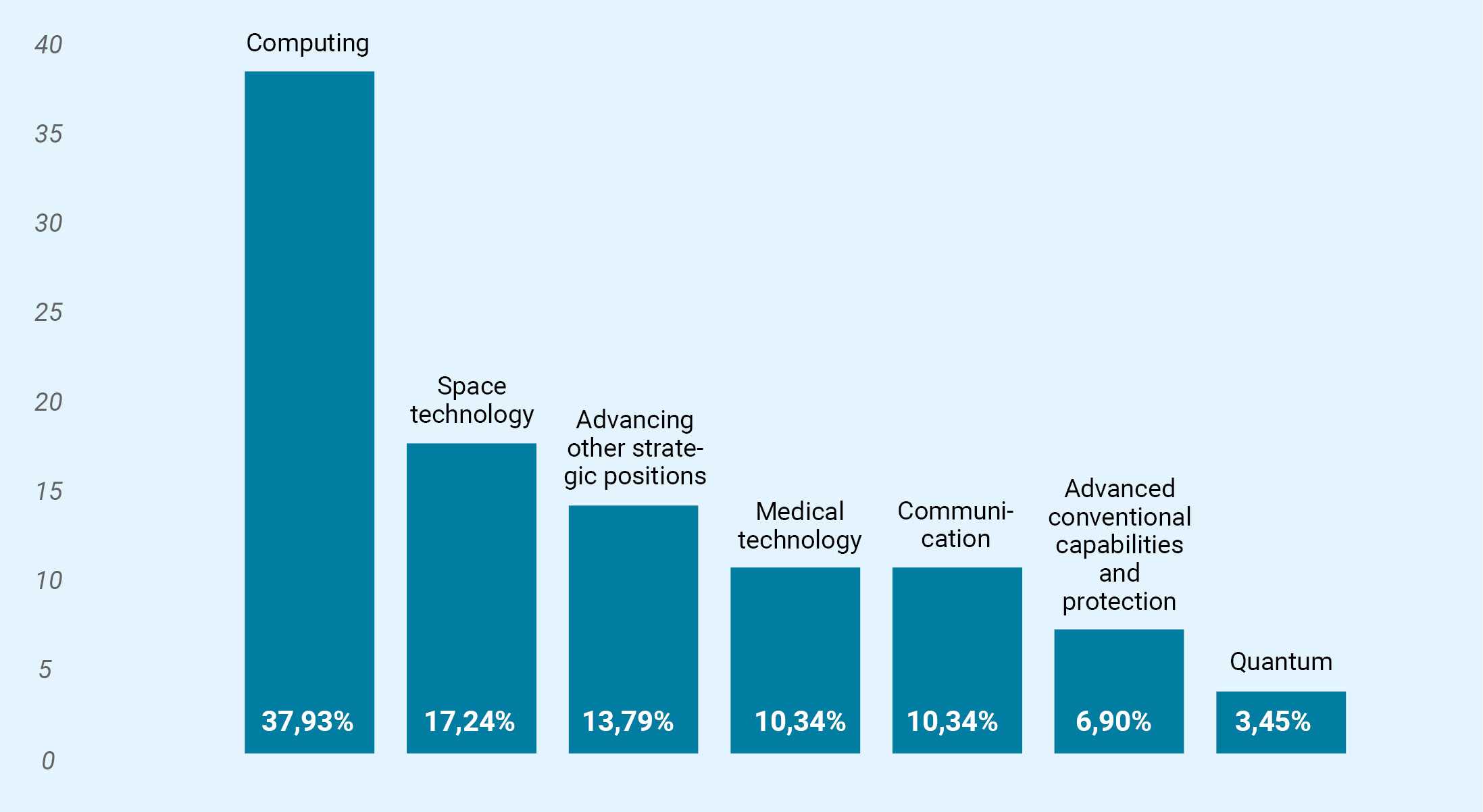
France
In its National Strategic Review, adopted in 2022, which builds on the previous version of the document, published in 2017, and an update published 2021, France sets out its objectives in the context of “a world of renewed tension” and the shift “from strategic competition to strategic confrontation.”9 Based on this, the country’s national security rests on three pillars: strategic autonomy as a nation but also as a leader within the European Union, resilience of its industry as well its society as a whole, and a strong military force that “remain[s] a power with a robust and credible nuclear deterrent.”10 Beside France’s nuclear deterrent or force de frappe, its colonial past and aspirations as nation that is active on the international stage have lead to the challenging requirement that the conventional capabilities of the French armed forces must cover the entire spectrum from global intervention to national and alliance defense. In addition, France stresses the idea that it is a “framework nation,”11 meaning that it has—at least in principle—full autonomy over its armament procurement and technological decisions and aims to develop and maintain an industrial base to allow this, and also to assume a leading role in the organization and coordination of multinational forces.
In France’s national security strategies, emerging and disruptive technologies for the military are only partially seen as a means of realizing this goal. They are primarily regarded as potential challenges that need to be addressed through measures such as the development of “first-class cyber resilience” and to counter the “actions of our competitors across the entire spectrum of hybridity” as an “essential part of the expression of power.”12 As far as its own military investments are concerned, France’s strategy papers indicate that traditional air, ground, and maritime systems are to be technologically upgraded so that they are optimally protected against both old and new threats. In addition, investments should be made in areas that help create a comprehensive and clear picture of the situation and identify new threats before they become a danger. The focus here is primarily on cyber and space, but also on more conventional reconnaissance technology, such as radar. However, France is also interested in offensive options, particularly in the area of cyber or stealth options. Somewhat surprisingly, AI plays a comparatively minor role when it comes to the military objectives listed in the country’s NSSs. Beyond these military goals, France strongly connects its national security with the ability to counter threats arising from “climate change and deteriorating biodiversity: food as a weapon, power and self-sufficiency [including] chemical, biological, radiological, and nuclear (CBRN) threats.”13
Germany
Germany's first national security strategy, adopted in 2023, takes a very broad understanding of security and covers a wide range of issues, from conventional military threats, security of energy supply (in response to dependence on Russian energy), and the secure supply of medicines to climate change and the protection of international order. Consequently, it devotes little attention to specific technologies, especially (emerging) military technologies. Instead, it addresses overarching strategic goals, such as integrated security and resilience, and the challenges the country faces in achieving these goals. One of the key challenges identified are cyberthreats from various actors and the vulnerabilities of critical systems, as became painfully clear in several situations over the past few years. The strategy also highlights the problems resulting from dependencies in the IT and semiconductor sectors during the COVID-19 pandemic as well as the discussion around the security implications of 5G mobile networks dominated by the Chinese. Based on this perspective, one of the few technological areas that are explicitly mentioned in the NSS are computing and communication technologies. Here, the leading priorities are AI and the availability of the necessary IT infrastructures, cybersecurity, and the development of networking infrastructures and technologies. Besides this, quantum computing and quantum-safe communication are other areas of focus. An overarching national goal that the strategy comprehensively addresses is the achievement and maintenance of overall social resilience. The abovementioned technologies and their economic value should also contribute to this overarching goal, in cooperation with European partners.
Japan
The national security strategy of Japan, published in 2022, highlights the fundamental challenges faced by the increasing international disorder and begins by focusing on military buildups in the region. It expands the understanding of national security by also including non-military issues, especially the economy, but makes a clear connection between military and economic power. China, North Korea, and Russia are explicitly named as states whose extensive armament is perceived as a threat. Russia and China are assumed to have an interest in territorial expansion and overthrowing the existing world order, while North Korea is seen as a direct threat primarily due to its missile and nuclear program.
The NSS elaborates on how and why Japan should follow its own national interests in light of this background. To this end, it outlines essential technologies for national security, including computing technologies, cybersecurity, AI, and data science, all of which play an important role for Japan. Further emphasis is placed on missile technologies, in particular advanced ballistic missile technologies, hypersonic technology and weapons using it, along with the corresponding missile and air defense. Advanced conventional capabilities and protection technologies have the highest priority for Japan. Intelligence capabilities and information warfare make up a huge part, while protection against CBRN weapons and the conventional capabilities of the Japan Self-Defense Forces are also accentuated. The technologies mentioned in the NSS are often referred to in connection with regional actors such as China and North Korea, which also expresses the significance of research and development for Japan in the respective areas.
Republic of Korea
The national security strategy of the Republic of Korea (ROK) was published in 2023 and presents a comprehensive approach to global problems, with North Korea’s continued advancement and deployment of its (tactical) nuclear and other WMD capabilities being seen as the most eminent threat in the near neighborhood. The nation acknowledges a shift in global politics, highlighting the significance of the intensifying competition between the United States and the People’s Republic of China, which has resulted in the militarization of industries and resources along with the fragmentation of global supply chains. In addition, present-day security threats, e.g., infectious diseases, climate change, and cyberattacks, are considered important aspects that need to be addressed.
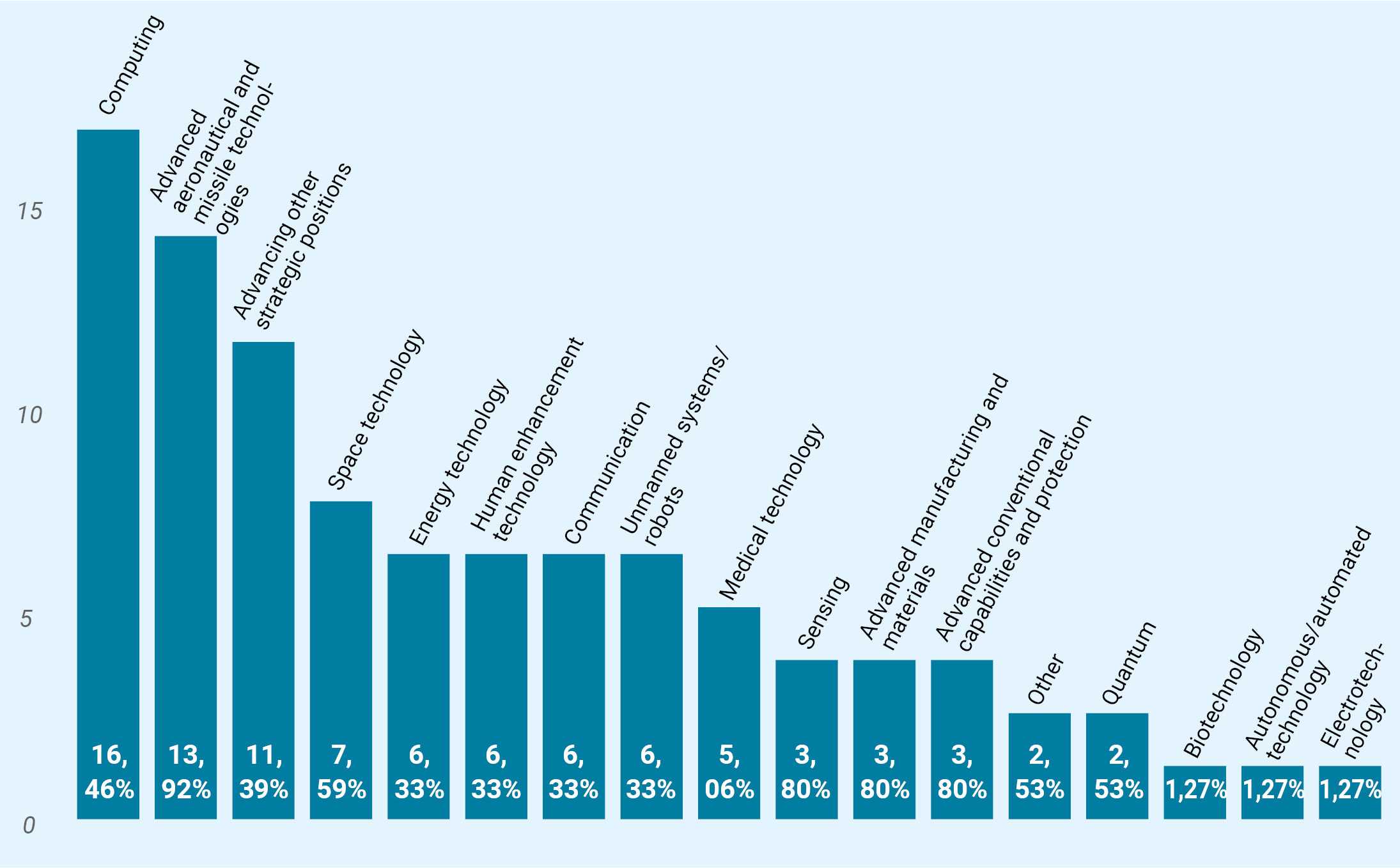
To this end, the NSS states that the development of a powerful military with a solid technological foundation is of the essence. The strategy emphasizes that enhancing the military should be prioritized due to its effect on ROK’s national security. Computing technologies play a particularly important role here. In this context, different applications based on AI and data science go hand in hand with offensive and defensive aspects of the cyber domain. The NSS also refers to the technologies needed for environmental solutions and agriculture, underlining the importance of nuclear technology in general. Another focal point is advanced aeronautical and missile technologies. With regard to North Korea’s capabilities and developments, including hypersonic weapons, the NSS concentrates on developing and further enhancing competent missile and air defense, as well as advanced ballistic and other missile technologies to counter and tackle potential attacks.
The Netherlands
As reflected in the Dutch diplomatic efforts in international fora, the three national and international security strategies from 2018, 2019, and 2023 refer to a shifting world, in which society and threats to national and international security are changing and transforming the international environment. Consequently, the strategies state that new, ever-changing, and potentially disruptive circumstances in different domains can affect national security and require the Kingdom of the Netherlands to adapt its security strategy. All three NSSs share a specific focus on digital threats and cybersecurity, while the latter is tied not only to national security but also societal peace, democratic continuity, and economic prosperity. Although the strategies name only a small number of technologies as a solution to security threats, they describe diverse political programs, such as monitoring and examining new technologies to counter potential threats. Developing and building on domestic technological efforts is seen as essential to protect the national security interests of the Netherlands. Moreover, the Kingdom is especially concerned about offensive cyberattacks that target the population and economy, leading to huge disruption. In a similar vein, the NSS emphasizes the risks of mis- and disinformation, which increasingly affect society and, in the context of information warfare, will lead to more hybrid conflicts, with no clear frontier but with broad security implications. An additional area of focus in the Dutch strategy is the proliferation and role of weapons of mass destruction internationally, demonstrating its interest in disarmament and international stability. Like other states, the Netherlands are sensitized to the consequences of climate change and the role played by technological progress in countering them.
Pakistan
The national security strategy of Pakistan, published in 2022, is the country’s first official document of its kind. It focuses on different aspects of security, ranging from geopolitics to more domestic matters, such as the economy, technology, and the well-being of the Pakistani population. Pakistan centers its national security understanding around economic security, in the belief that this is necessary to counter threats and other security challenges. These threats include economic disruption, deficiencies in public service and natural and health-related threats. In terms of the traditional concept of security, Pakistan is concerned about terrorism and the buildup of conventional forces within the region, which might infringe on its territorial sovereignty. The latter is emphasized several times throughout the strategy. It is no surprise that Pakistan, as a nuclear power, views nuclear deterrence as an indispensable means of protecting its national security. However, the strategy considers threats in and across all domains and the need to expand its conventional capabilities in order to face these challenges and defend its national security. It is also important to note here that the NSS refers to India on several occasions, criticizing it for having hegemonic claims while simultaneously building up its army through advanced technologies. This also reflects the importance of closing the technological gap for Pakistan, especially with respect to India.
At first glance, the strategy seems to draw a distinction between military means such as the modernization of conventional military capabilities as well as electronic warfare and technologies for civilian purposes, which are needed not only to address security concerns but for the overall development of Pakistan. These technologies include computing technologies as well as applications based on AI and data science, including safe and efficient communication capabilities across all domains, and are a top priority for Pakistan. In connection with the aforementioned technologies, the NSS also focuses on cybersecurity and defense. On closer examination, the strategy indicates that a technological core is envisaged for Pakistan’s overall economic development, while also stating that benefits and progress from this development will be reallocated to defense capabilities in order to tackle evolving threats to the country’s national security.
Poland
Poland’s national security strategy, adopted in 2020, contains a clear vision of national interests, internal and external problems and opportunities, as well as technological development, be it civilian or military. The NSS emphasizes the growing rivalry between the US, the PRC as well as Russia and outlines its effects on international relations. While the US is referred to as a partner and the PRC is mentioned only once, Russia is given a distinct role in Poland’s NSS. It is noteworthy that Poland already expresses the risks posed by Russia’s “neo-imperial policy” in 2020. Building on this, Russia is seen as the “most serious threat” to Poland’s national security, as well as to the security of the international system in general. Russia’s “intensive development” of its military capabilities is also described as another threat that Poland and its international partners in Europe are confronted with.14
Consequently, the development and promotion of “new technologies”15 with a military focus is seen as a necessity for Poland’s national security. At first, in light of Russian aggression in the country’s neighborhood, the NSS opts for proactive participation in a policy on nuclear deterrence under the auspices of NATO. In addition, Poland’s NSS emphasizes the importance of technological advancements in ballistic missiles and other missile technologies and their respective countermeasures, e.g., air and missile defense. Despite having a broad view of emerging and disruptive technologies, the focus of the NSS is on technological fields such as computing and communication. It states that network and electromagnetic technologies, together with advanced command and control16 drawing on new methods of encryption and network security, will have a huge impact on Poland’s competitiveness on an international level. When it comes to computing technologies, the NSS underlines the importance of implementing AI as well as cybersecurity and offensive cyber instruments for Poland’s national interests.
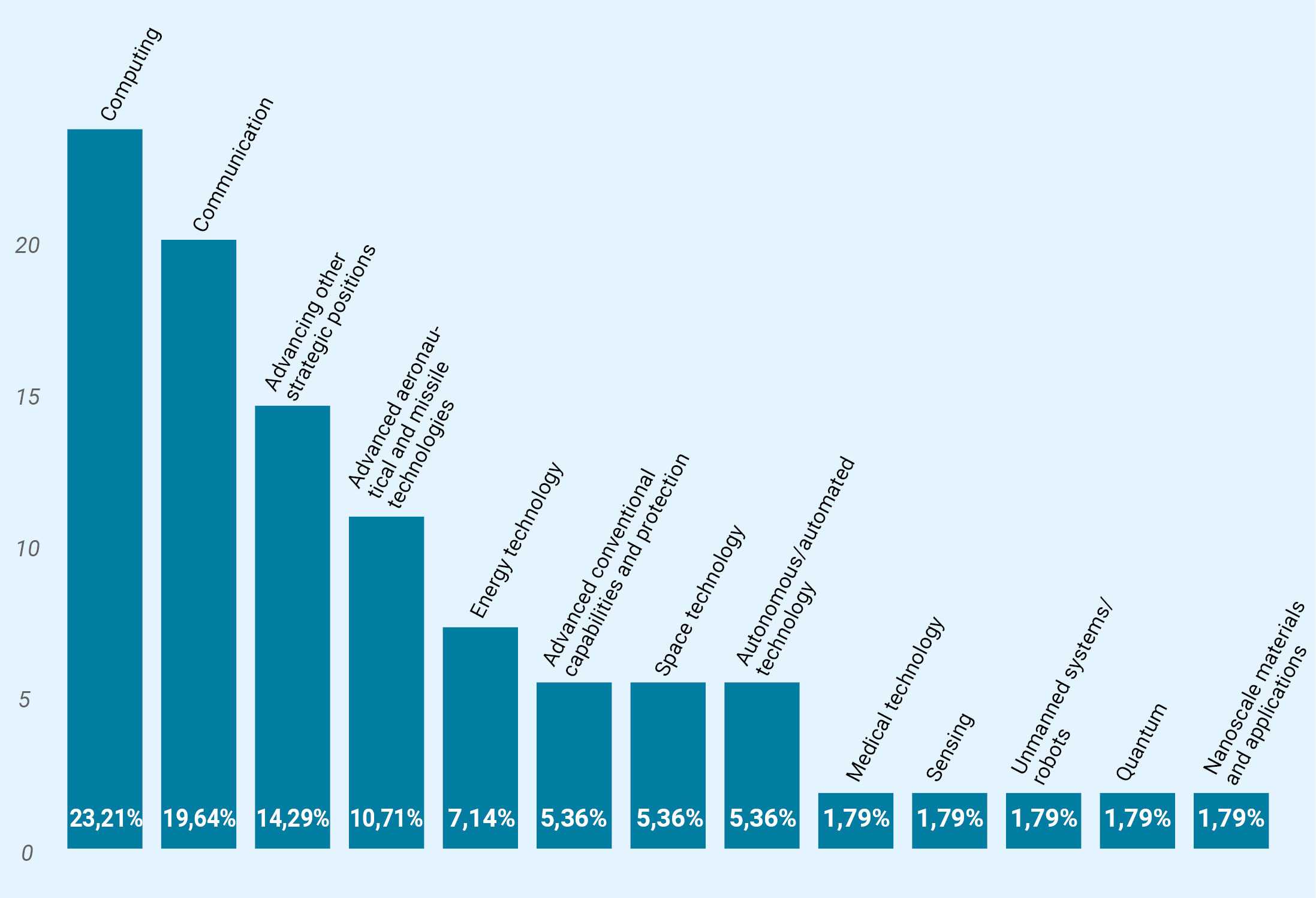
Russia
In general, Russia’s national security strategy, adopted in 2021, places significant emphasis on upholding and safeguarding the rights and freedoms of its individuals and citizens, and aims to mitigate external and domestic threats that have a negative impact on this. Against the backdrop of these priorities, the strategy identifies several threats, such as biological risks and their impact on citizens’ health, life expectancy, and mortality, or the destabilizing impact of internet communication and false information and their effects on the social and political situation. With regards to the military realm, the strategy accentuates that military force is increasingly being utilized by actors in international relations to attain their geopolitical objectives. A specific threat to strategic stability and international security is the deployment of medium- and short-range missiles in Europe and the Asia-Pacific region, as well as escalation of tensions in regions in and around the post-Soviet space, Afghanistan, the Korean peninsula, and the Middle East. Russia’s approach to counter these threats is to maintain its technological independence by promoting its defense industrial complex, fostering innovation, and continuing to create and develop new models, complexes, and systems for civilian and military purposes. Therefore, scientific and technological progress is seen as essential for international competitiveness and national security. The NSS places an emphasis on advanced manufacturing and materials, such as additive manufacturing, nuclear technology for power generation, and environmental solutions. Moreover, the capacity of nuclear deterrence to protect national interests plays an important role. Computing technologies using a combination of AI, high-performance computing, data science, and aspects of cybersecurity, as well as measures to protect citizens from false information and to improve “information security,” are other key areas that feature in Russia’s NSS.
Spain
Spain’s national security strategies, published in 2017 and 2021, are both highly comprehensive documents. The strategies take a detailed look at global transformation processes, in terms of security policy, the economy, and the environment, and discuss the risks, dangers, and need for adaptation that these entail for Spain. The NSSs also emphasize the rivalry between the US and China, especially in the technological sphere. Moreover, China’s advancement in “critical and dual-use technologies”17 is seen as an aspect which has the potential to further exacerbate international conflicts. India, Iran, Russia, and Türkiye are also mentioned as regional actors trying to strengthen their position on the international level. Spain’s answer to the changing international environment is based on a holistic approach and it even proposes a model for preventing crisis situations that should be placed within the framework of the national security system. The main technological pillars for this system are computing and energy-related technologies. Given the geopolitical role of Spain as a producer of solar energy, but also as a key player in the transfer of renewable energy from Africa to Europe, energy transport and transmission technologies, as well as energy storage systems, infrastructures, and new energy materials are strongly emphasized. Besides this focus, the strategy’s broad analysis and its society-wide perspective means many other technologies and technological areas are considered EDTs. Computing technologies, such as AI and cybersecurity, are top priorities. Further, space-related topics such as microsatellites for communication, navigation, and surveillance, as well as a broader security vision for space play an important role. Another key takeaway from Spain’s NSSs is the emphasis on the intertwinement of technology, the economy, and geopolitical confrontation, which further highlights the relevance of technological progress for Spain’s national security.
The United Kingdom
The UK’s two strategies, published in 2021 and 2023 respectively, clearly reflect the changing international environment. While the 2021 paper describes a fragmented international community and challenges to the UK’s domestic security, prosperity, and sovereignty, exacerbated by climate change, health crises, and threats to its liberal democracy, the 2023 “refresh” is more explicit, with a stronger focus on traditional security threats and geopolitical changes and security challenges, especially in relation to Russia and China. Both papers refer to the many achievements of the UK and describe its current economic, military, and diplomatic capabilities detail. Technologies are mentioned as components of such capabilities, as technological change is understood as one of the main factors shaping the international environment.
In a post-Brexit context, the NSS emphasizes the growing importance of international alliances and new partners that share the same interests. In terms of priority technologies, as a nuclear power, the UK mentions its capabilities and nuclear posture most frequently in its NSSs. Alongside nuclear weapons and their importance to security and stability, the UK emphasizes the importance of the conventional platforms needed to ensure its military power, mirroring the focus of the strategies on being prepared to defend the country’s domestic security. Digital technologies are less prominent in the UK’s NSSs, meaning they were mentioned in less detail than technologies related to the UK’s nuclear and conventional arsenal. That being said, this does not mean that digital technologies are not a priority for the UK, as it can be assumed that they are understood as emerging technologies, which are indeed mentioned several times as a central factor in the global competition. However, there is only one point in the strategies where examples of digital technologies are given, in the form of AI, quantum technologies, and synthetic biology. Because the UK has a long-established strategic culture, additional security- and defense-related strategies exist, zooming in on military science, technology, and innovation in the digital and conventional realms.
The United States
The two NSSs from the US (2017 and 2022) analyzed for this study are each characterized by a distinct risk analysis and understanding of security. They do not, however, diverge on the wider strategic threat perception in regards to great power competition with China and Russia. Both strategies declare the two states as challengers in a global competition for power and hegemony. While the 2017 strategy considers other threats to national security by contrasting the domestic sphere to the international realm, the 2022 strategy considers more transnational threats, such as climate change and pandemics, and ties international efforts to national security. The importance of military might and nuclear weapons is a common theme, either to signal strength and use this as an advantage or with the aim of using such military capabilities for deterrence and security.
For the US, technological innovation is primarily seen as a tool to maintain the country’s competitive advantage, as technology is understood as being at the heart of the great power competition and therefore decisive for national security. The NSSs show that the US intends to maintain its lead in technology by further enhancing its research and development in emerging disruptive technologies—a topic that the US has been pursuing since at least the 1990s under the slogan “keeping the technological edge.”18
The NSSs focus on computing technologies such as (reliable/trusted) AI, data science, and applications of high-performance computing in combination with cybersecurity and defense. Further, the US underlines the significance of CBRN protection, as well as technologies for (defensive) intelligence capabilities and information warfare. As well as these areas, the US also emphasizes the importance of space technologies, especially those that enable further communication and surveillance capabilities. Energy technologies, specifically renewable energy, energy independence and its management, storage, and efficient usage, also play an important role. Moreover, energy is seen as a field in which the US can assert dominance and further increase its competitive advantage. The latter is the main takeaway from the US NSSs. Both strategies clearly focus on further enhancing and maintaining the country’s technological advantage, especially given its power competition with states such as Russia and China.
The Aggregated Level: Focal Points and Blind Spots
Comparing the data across countries and looking at aggregated values generates some interesting observations, a few of which will be described here by way of example.
First, it is important to note that a national security strategy is the most important document for national security policy. If individual new military technologies are considered relevant and worth pursuing here, this is significant. The more of these technologies are mentioned, the more likely it is that a state will strive to reshape and reorganize its military, or at least align it technologically . A wide range of technologies are mentioned in the NSSs. While the German NSS mentions just 5 of the 18 technology categories (followed by Belgium with 7), the Korean NSS mentions 17. Although it is not surprising that the NSSs adopted in the US and the UK also mention a large number of technology categories (14 and 15, respectively), the Spanish NSS refers to an astonishing 15 technologies. Russia, like Poland, mentions 13 categories as important, France 11.
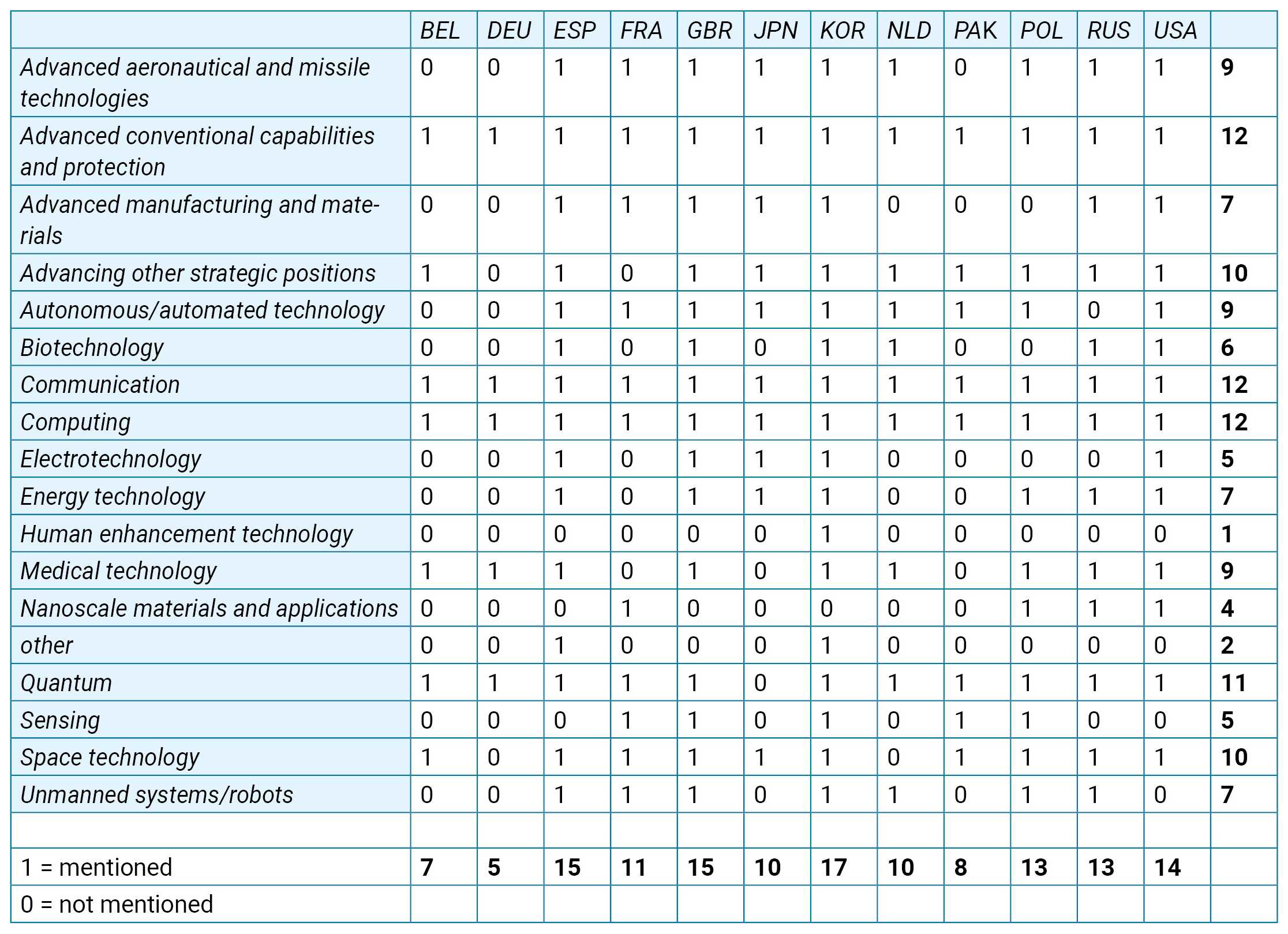
But which countries show similarities in terms of the technologies they mention? The US has similar priorities to the UK, Russia, and—surprisingly—Spain, and is least similar to Germany. The latter, on the other hand, has similar technology priorities to Belgium, followed by Korea and Pakistan. In general, Germany’s priorities differ significantly from those of its bigger EU and NATO partners, e.g., Spain, the UK, or the US. These three states form a group with rather similar priorities. Yet, Russia, too, has similar technology priorities to the US, or the UK.
Focal Points: Dominant Security-Relevant Technologies
Given the wide range of potential technologies available, some stand out as more significant than others and are specifically reflected in the respective NSSs. The following graph provides an overview of the share of the 12 countries under consideration that mentioned the respective technological field in their NSSs.
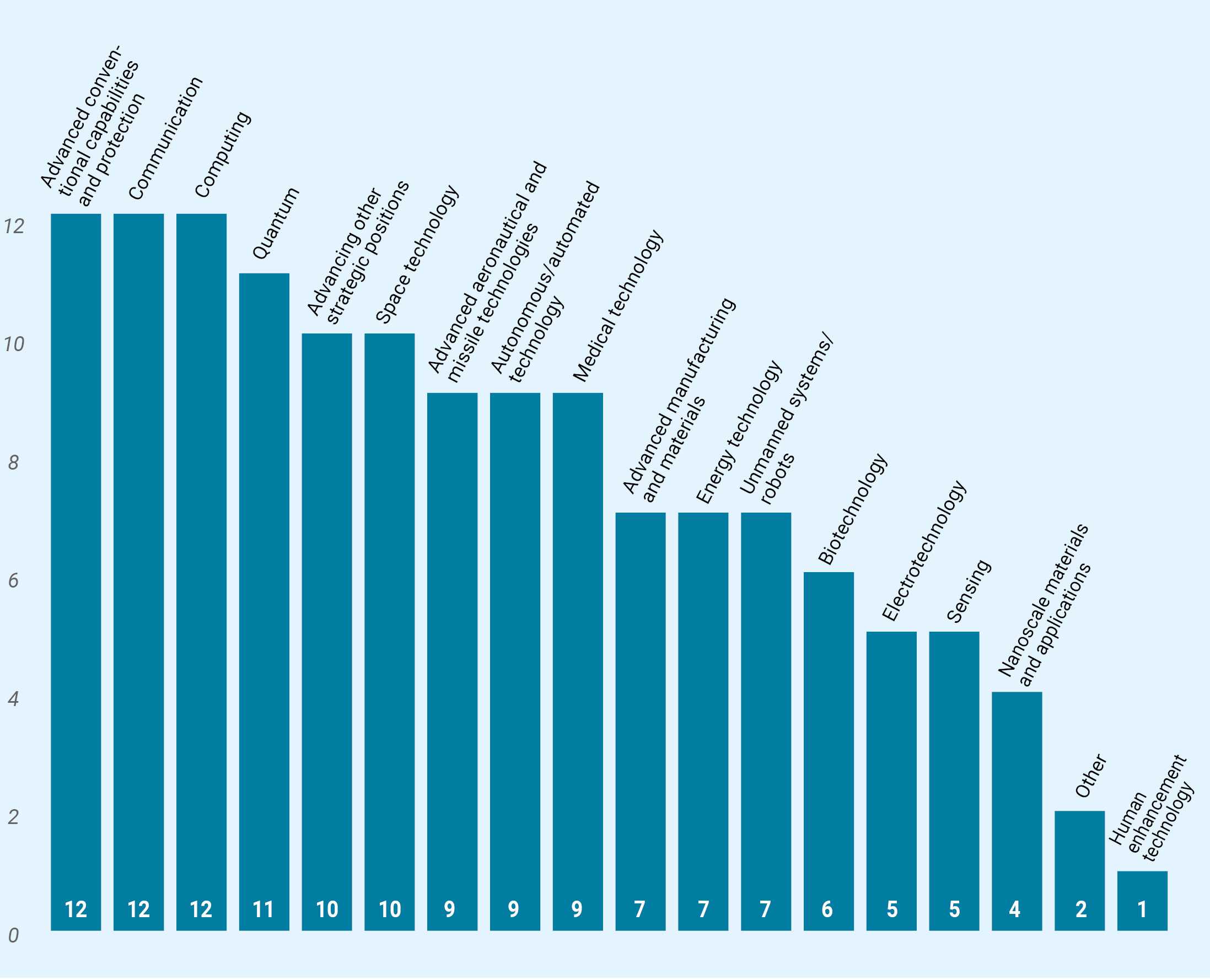
Three technological fields, in particular, stand out, as they are considered relevant by all the countries being studied here. The areas are: communication, computing, and “advanced conventional capabilities and protection,” followed by quantum, which was mentioned by 11 of the 12 countries.
The fact that “computing” scores so highly does not come as much of a surprise here, as the category includes the areas of emerging activities in the cyber domain and AI which have been discussed particularly intensively. All 12 countries refer to these topics, with digital challenges and responses to those challenges being by far the most frequently mentioned category. Given the prominence of cyberattacks since the early 2000s, this is also hardly surprising.
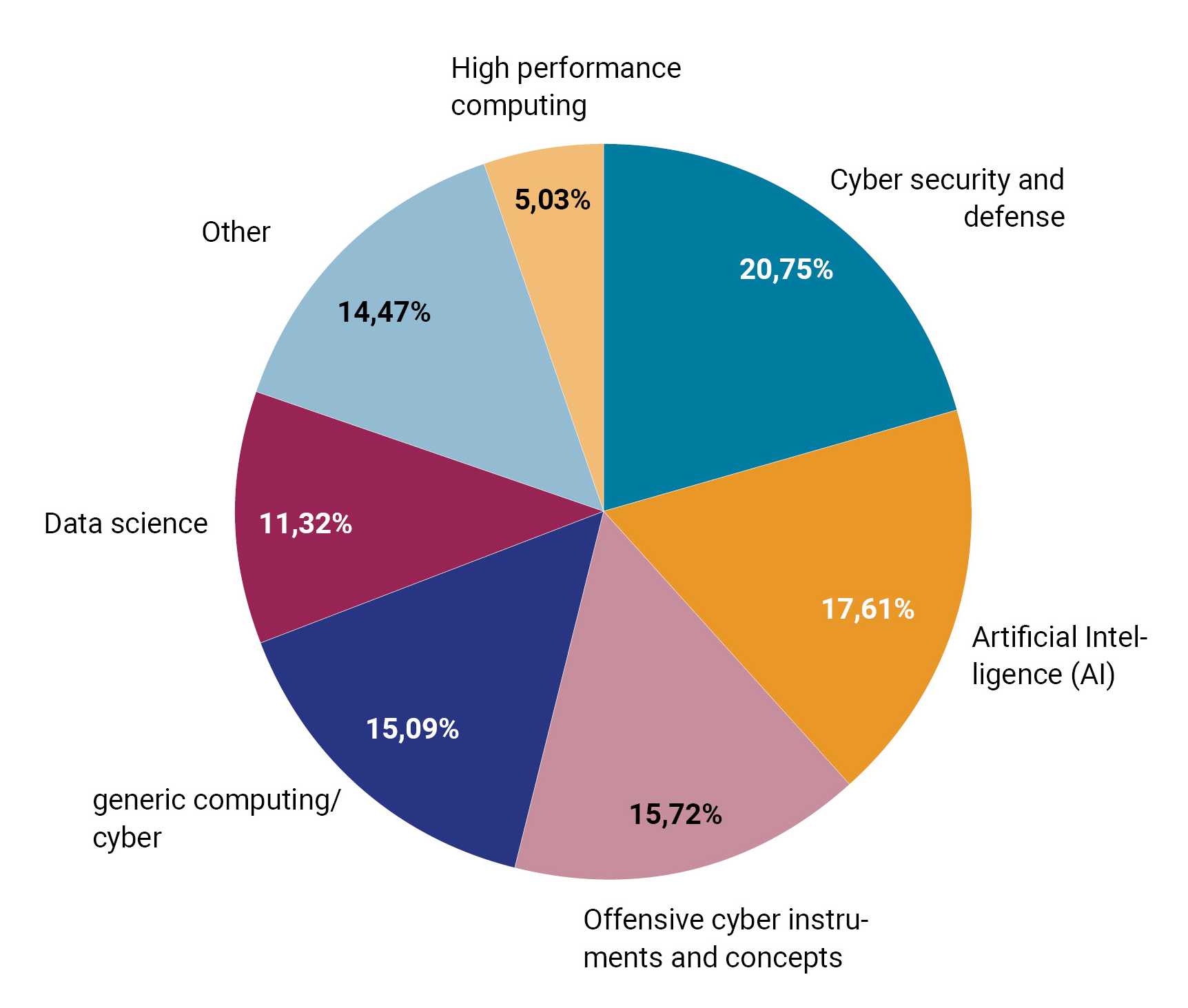
A closer look reveals that cybersecurity and defensive measures, but also offensive cyber capabilities, play a particularly important role. This explicit interest in offensive cyber operations, which is expressed here at the level of the NSS, is alarming in that it fuels fears of surprise attacks and of a “cyber arms race,” leading to more dangerous dynamics in the field of armaments. In the context of computing, AI is also a frequently mentioned buzzword, but remains interestingly vague in terms of specific uses, at least at this level. More concrete issues mentioned include, in particular, data science, that is finding patterns of interest in large chunks of data, sometimes from different sources. Artificial intelligence is sometimes also related to the development of autonomous systems. It is anticipated to change large parts of society, so most militaries assume that the impact on warfare and military operations will also be huge. What is interesting, however, is that especially in this field, some countries seem to derive more military benefit from the dual-use relevance of AI than others. While, for example, there seems to be some reluctance among Western AI programmers to let their products be used by the military (with the refusal of Google programmers to participate in the “Maven” project being the most visible example19 ), these reservations are much less pronounced in other countries, such as China, for example. This dynamic might change though, considering the prevalence of Silicon Valley and other formerly civilian IT service providers in Ukraine now designing products specifically for military applications.20
The second category that all states agree on is the related field of communication, with a specific focus on networking technology, encryption, and network security—another example of civilian and military applications of the same technologies intersecting. Other emerging aspects of communication with a stronger military focus, such as new forms of command and control or electronic warfare, follow somewhat further behind. However, this may be due to the fact that these aspects are too specific to the military for the national security strategies, and it can be assumed that greater importance is attached to these technologies in national strategies that are more focused on military research and development.
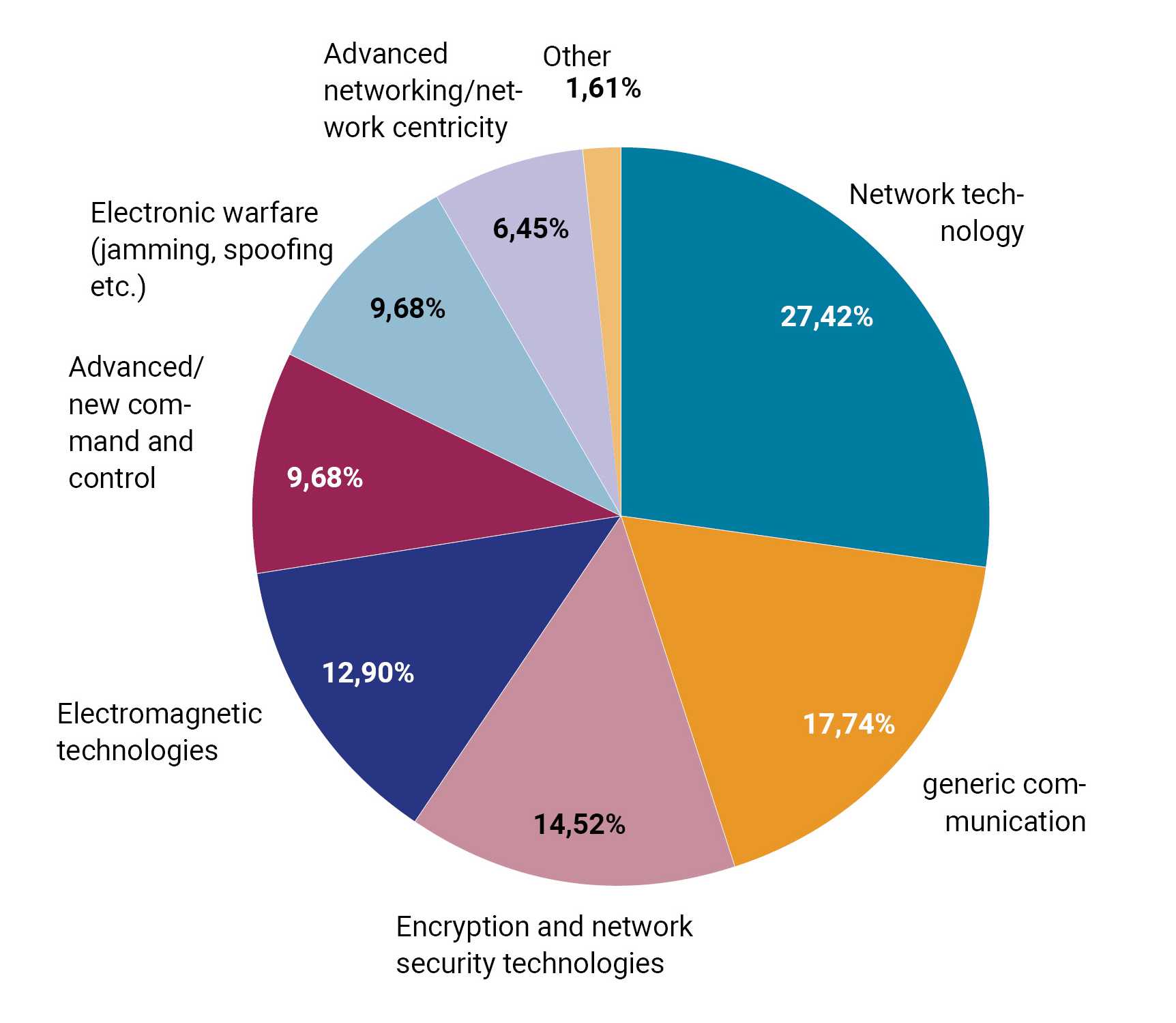
The third field where all states see the need to invest in technology is “advanced capabilities and protection,” with the focus there being mostly on already existing technologies. This category features technology, processes, materials, and applications that aim to improve conventional armament and protection capabilities not covered by any other category. It therefore focuses more on the evolutionary improvement of existing technologies, for example CBRN protection, more conventional protection, next-generation land, sea, or systems, improvements in signature management, or even advanced explosives or ammunition. The improvement of intelligence capabilities and the reinforcement of infrastructure against information warfare also feature prominently in this category.
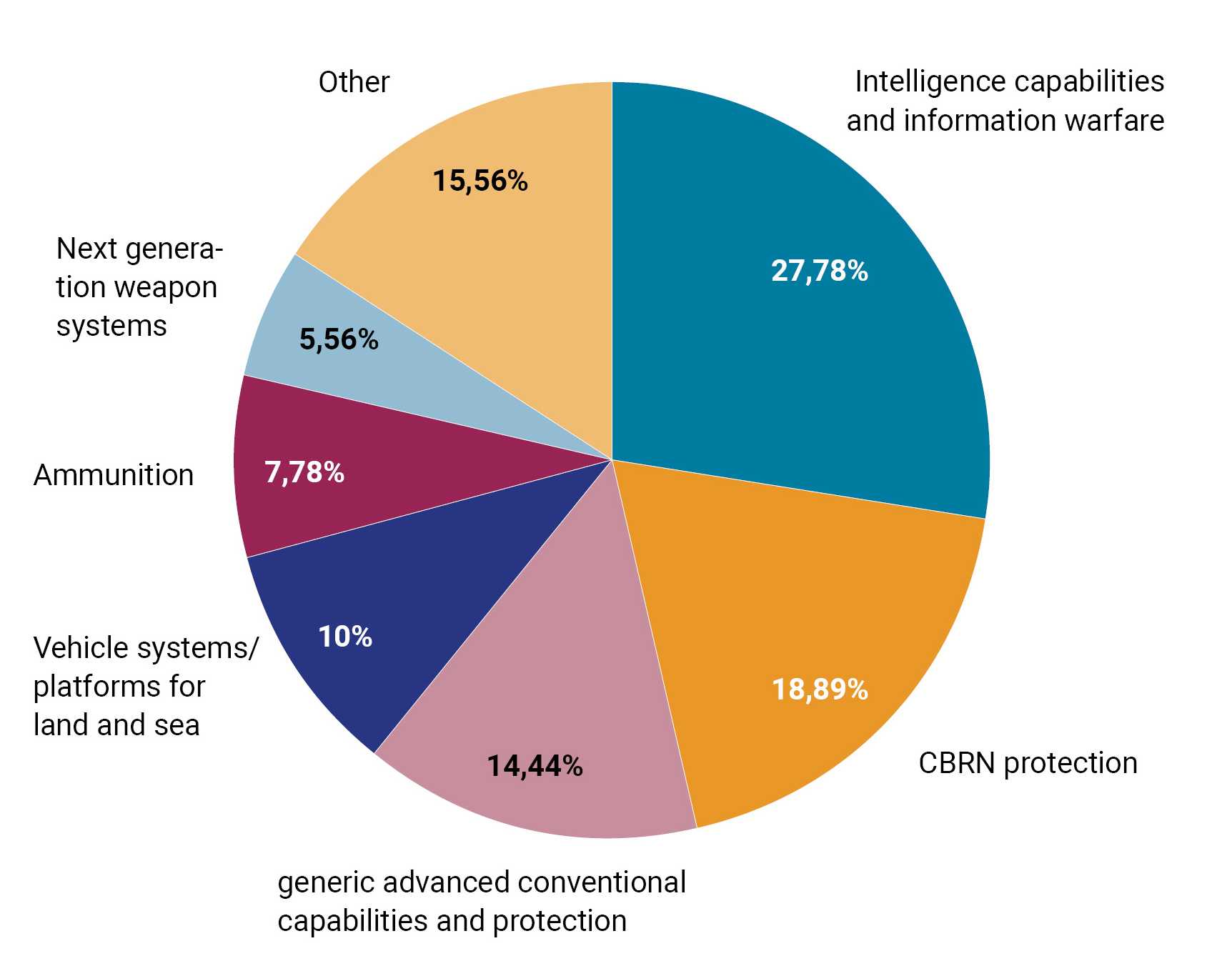
The fourth category, mentioned by 11 of the 12 states, with Japan being the only exception, is quantum technology. Given the fact that quantum is a fairly new topic compared to many of the other technologies debated here, this is rather surprising. Although there seems to be uncertainty about the possible applications in this area, the general view is that this topic has significant potential for disruption, especially through decryption and the undermining of current approaches to secure communication. However, similar to AI, references to specific applications beyond generic mentions of “quantum” are rare, with “quantum computing” being the most prominent, followed by quantum sensing and imaging, as well as quantum communication (see figure 8).
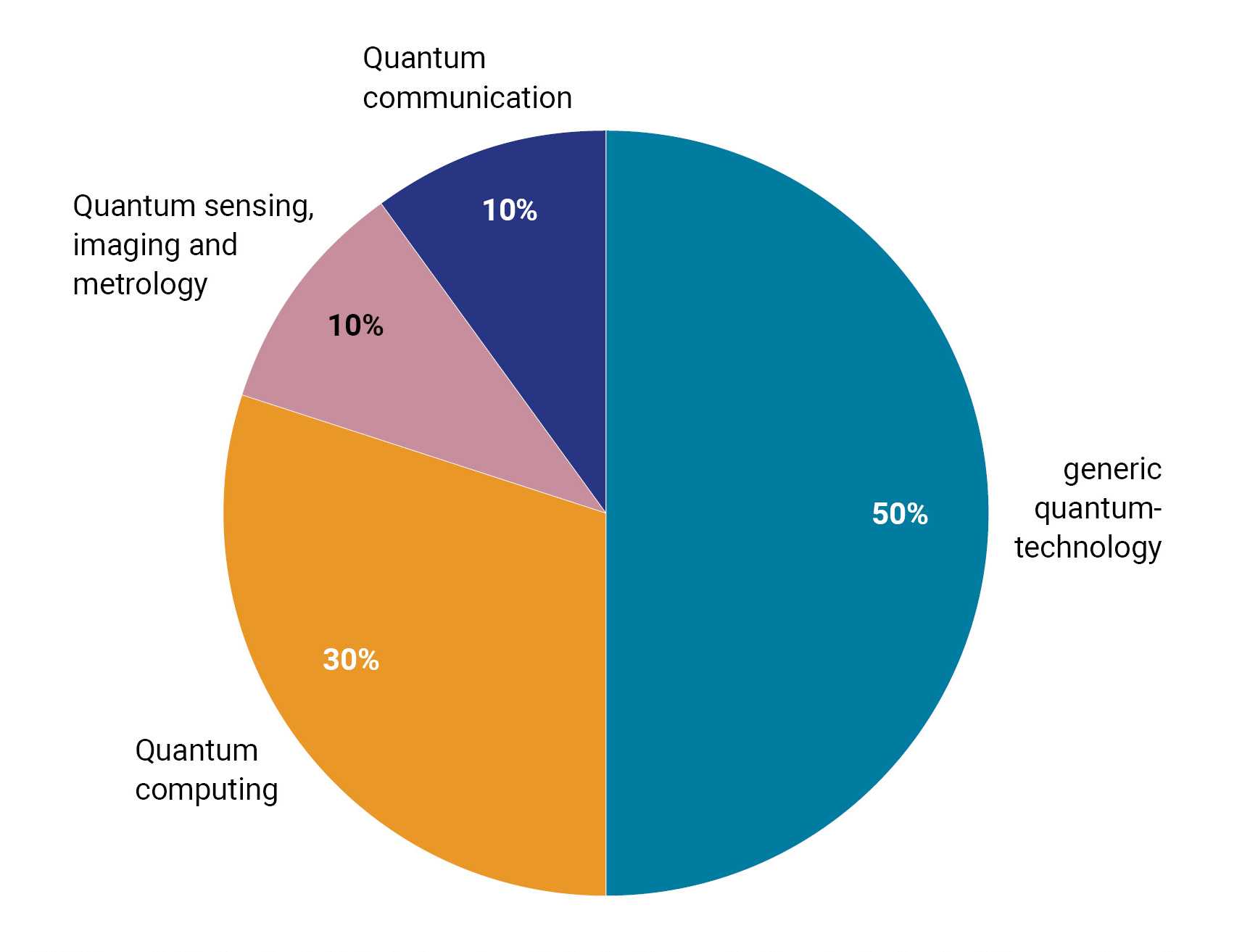
Blind Spots
What is also interesting, however, is which technologies often categorized as EDTs are in fact missing. Human enhancement, as the most striking example, is only mentioned by one country—the Republic of Korea. Human enhancement is a vast field in itself, covering issues ranging from removable items such as night vision goggles or exoskeletons to performance-enhancing drugs or even body modifications, including implanted chips or artificial limbs (usually as prothesis). Many of these technologies are rather new, often resemble “science fiction,” but, for example, much research is being done in the field of human–machine interaction to optimize the interface between computers and the human bottleneck. Research in this area is still in its infancy but given the dual benefits of human–machine interaction, it seems plausible to expect that the momentum and successes in the civilian sector will stimulate broader military interest. This area should therefore be kept in mind and monitored closely.
Other “blind spots” of several technologies that are relatively rarely mentioned include those falling into the category of “nano technology” (mentioned by four states) and “sensing” (mentioned by five states). Finally, even if it cannot be claimed that the “unmanned systems/robots” category is “rarely” mentioned in a strict sense, as 7 out of 12 states refer to it, we consider this result to be surprisingly low. This could be due to the fact that the special role that drones will play in the conflicts of the future has only become clear as a result of Russia’s war against Ukraine and has not yet been reflected in the NSSs. Another explanation could be that remotely piloted drones are not seen as “emerging” anymore, as more states (nine) see automated or even autonomous systems as relevant. In any case, it would be important to pursue this further, especially given the tremendous impact of the formerly civilian technology of micro-drones or hobbyist drones on the battlefields of the 2020s.
Conclusion
Our analysis of national security strategies has shown that at this level, states not only have very different understandings of security but consequently also have very different priorities regarding the use of new technologies for security purposes. While some states are very reluctant to express their interest in new technologies, others recognize the need to introduce a broad spectrum of emerging technologies into the military or at least adjust their technological preferences in that direction.
Interestingly, the West, or the NATO countries analyzed, did not appear as a unified bloc with the same technology preferences. Instead, it can be assumed that threat perceptions, each country’s positionality in the international system and historical enthusiasm for technology determine their individual technology preferences.
The analysis also shows that certain technologies are considered relevant by practically all states—including the, now established, area of cyber defense and cyber warfare, state-of-the-art communication, or the use of AI—while other technologies have not yet reached this level. It is also interesting that almost all states regard the use of “quantum” as relevant to security, although in the vast majority of cases quantum applications have at best achieved the status of a “proof of concept.” From this perspective, the realization of the need for comprehensive and broad-based digitalization of the armed forces has now reached the highest levels, at least in terms of rhetoric. However, focusing on the digital is not without its risks, as you can’t hold ground with cyber” in a military conflict.
It is also interesting how the discussion evolving around dual-use technologies finds its way into national security strategies. On the one hand, the strategies are used to describe the intent of an adversary to use technology that is interchangeable between the civilian and military domains. One example is the USA’s NSS from 2022, where the PRC is referred to as an actor that repurposes the scientific findings of civilian research to profit from dual-use aspects for military applications. A closer look at other NSSs reveals that building bridges between civilian and military technologies is not an exception. The NSSs of Japan, Pakistan, the Republic of Korea, and Russia emphasize that the transfer of knowledge from the private, economic, and civilian sectors to the military domain could help to further enhance military technologies.
In this regard, it is essential to consider how national positions on technology in the context of the NSSs impact discussions about the problem of dual-use technologies, especially in light of increasing global competition, in which such technologies often play a key role. For example, despite many German universities having civil clauses, there is also a long tradition of coordination between the Federal Ministry of Education and Research (BMBF) and the Ministry of Defense (BMVg).
However, our analysis also shows that more in-depth research is needed and that the NSSs do not tell the whole story . One of the reasons for this is that the broad-based security strategies, in particular, do not differentiate between technologies that are civilian use only or dual-use, technologies that represent a continuation of an existing technology at a higher level and genuinely new, emergent technologies that provide the military with completely new capabilities and may also have a disruptive effect. Many questions therefore remain unanswered, which further research by CNTR will address. For when it comes to the question of regulation and even arms control, the fact that many of the technologies seen as relevant are indeed dual use will make it harder to find solutions that the majority of actors can agree on. The Chemical Weapons Convention (CWC) proves that it is not unfeasible to implement strict verification measures even in an area where there is a possibility of unlawful use. However, long-established normative reservations, which do not apply to many “emerging” technologies, also play a role here. International endeavors are currently underway, such as the discussion in the CCW about lethal autonomous weapon systems. Approaches to cyber arms control do exist, even though they are still in their infancy. There are strategies to regulate, for example, the hardware needed for high performance and with the REAIM conference initiated by the Netherlands and the Republic of South Korea, an international forum is beginning to form to discuss the responsible use of military AI.
- Republic of Poland (2020). National Security Strategy of the Republic of Poland. https://www.bbn.gov.pl/ftp/dokumenty/National_Security_Strategy_of_the_Republic_of_Poland_2020.pdf; see p. 7, our emphasis. See also German National Security Strategy (2023) [Nationale Sicherheitsstrategie Deutschlands]. https://www.nationalesicherheitsstrategie.de/National-Security-Strategy-EN.pdf; pp. 24 and 54. ↩
- European Union. https://eda.europa.eu/webzine/issue22/cover-story/driven-by-global-threats-shaped-by-civil-high-tech ↩
- NATO. https://www.nato.int/cps/en/natohq/topics_184303.html ↩
- However, the comparison shows that the EDA understands “space and hypersonic systems” as one technological category, while NATO separates these two categories. ↩
- Clapp, S. (2022). Emerging disruptive technologies in defence. European Parliamentary Research Service. https://www.europarl.europa.eu/RegData/etudes/ATAG/2022/733647/EPRS_ATA(2022)733647_EN.pdf; see p. 1. ↩
- European Union. https://eda.europa.eu/webzine/issue22/cover-story/driven-by-global-threats-shaped-by-civil-high-tech ↩
- Schörnig, N. (2014). Liberal Preferences as an Explanation for Technology Choices. The Case of Military Robots as a Solution to the West‘s Casualty Aversion. In M. Meyer, M. Carpes, R. Knoblich (Ed.). The Global Politics of Science and Technology - Vol. 2 (pp. 67-82). Springer; Csernatoni, R., & Martins, B. O. (2023). Disruptive Technologies for Security and Defence: Temporality, Performativity and Imagination. Geopolitics, 29(3), 849–872. https://doi.org/10.1080/14650045.2023.2224235 ↩
- The countries in this text are listed in alphabetical order. ↩
- République Française (2022). National strategic review – 2022. https://www.sgdsn.gouv.fr/files/files/rns-uk-20221202.pdf; see p. 9. ↩
- République Française, 2022; see p. 27. ↩
- République Française, 2022; see p. 23, 27, 41, 44, 50. ↩
- République Française, 2022; see p. 27; République Française; see p. 8. ↩
- République Française; see p. 22. ↩
- Republic of Poland, 2020; see p. 6. ↩
- Republic of Poland, 2020; see p. 7. ↩
- Republic of Poland, 2020; see p. 18. ↩
- Kingdom of Spain (2021). National Security Strategy 2021. https://www.dsn.gob.es/es/documento/estrategia-seguridad-nacional-2021; see p. 27, our translation. ↩
- Carter, A. B. (2001). Keeping the Edge. Managing Defense for the Future. In A. B. Carter & J. P. White (Ed.), Keeping the Edge. Managing Defense for the Future (pp. 1–25). MIT Press. ↩
- Shane, S. & Wakabayashi, D. (2018, April 4). ‘The Business of War’: Google Employees Protest Work for the Pentagon. The New York Times. https://www.nytimes.com/2018/04/04/technology/google-letter-ceo-pentagon-project.html ↩
- Bergengruen, V. (2024, February 8). How Tech Giants Turned Ukraine Into an AI War Lab. Time. https://time.com/6691662/ai-ukraine-war-palantir/ ↩